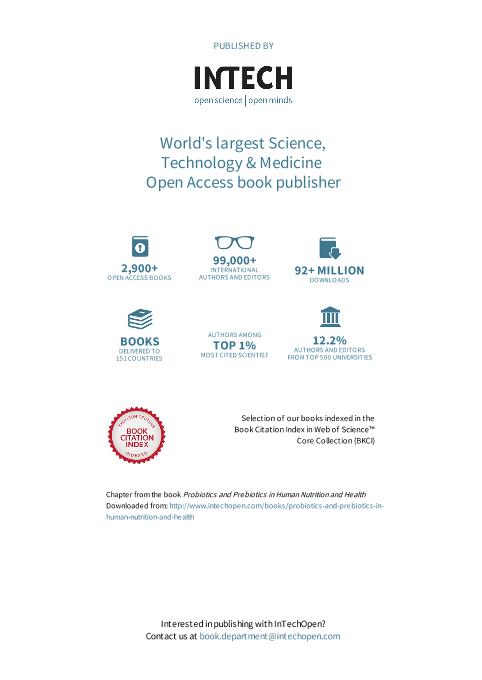Mostrar el registro sencillo del ítem
dc.contributor.author
Kling, Danielle N.
dc.contributor.author
Marcial, Guillermo Emilio

dc.contributor.author
Roberson, Dana N.
dc.contributor.author
Lorca, Graciela L.

dc.contributor.author
Gonzalez, Claudio Fabricio

dc.contributor.other
Rao, Venketeshwer
dc.contributor.other
Rao, Leticia
dc.date.available
2021-09-03T14:38:39Z
dc.date.issued
2016
dc.identifier.citation
Kling, Danielle N.; Marcial, Guillermo Emilio; Roberson, Dana N.; Lorca, Graciela L.; Gonzalez, Claudio Fabricio; The Synergistic Contribution of Lactobacillus and Dietary Phytophenols in Host Health; IntechOpen; 2016; 83-113
dc.identifier.isbn
978-953-51-2476-4
dc.identifier.uri
http://hdl.handle.net/11336/139638
dc.description.abstract
Phytophenols are found ubiquitously among all plants. They are important in diets rich in fruits and vegetables because these compounds provide health benefits to the host, ultimately decreasing the incidence of chronic diseases. These compounds act as natural antioxidants and provide anti-inflammatory, antiviral, antibiotic, and antineoplastic properties. Reactive oxygen species (ROS) are produced under normal physiological functions, and low/moderate levels are required for cellular turnover and signaling. However, when ROS levels become too high, oxidative stress can occur. Phytophenols quench ROS and ultimately avoid the damaging effects ROS elicit on the cell. The highest source of bioavailable phytophenols comes from our diet as a component usually esterified in plant fiber. For phytophenols to be absorbed by the body, they must be released by esterases, or other related enzymes. The highest amount of esterase activity comes from the gastrointestinal (GI) microbiota; therefore, the host requires the activity of mutualis‐ tic bacteria in the GI tract to release absorbable phytophenols. For this reason, mutualis‐ tic bacteria have been investigated for beneficial properties in the host. Our laboratory has begun studying the interaction of Lactobacillus johnsonii N6.2 with the host since it was found to be negatively correlated with type 1 diabetes (T1D). Analyses of this strain have revealed two important characteristics: (1) It has the ability to release phytophenols from dietary fiber through the secretion of two strong cinnamoyl esterases and (2) L. johnso‐ nii also has the ability to generate significant amounts of H2O2, controlling the activity of indoleamine 2,3-dioxygenase (IDO), an immunomodulatory enzyme.
dc.format
application/pdf
dc.language.iso
eng
dc.publisher
IntechOpen

dc.rights
info:eu-repo/semantics/openAccess
dc.rights.uri
https://creativecommons.org/licenses/by-nc-sa/2.5/ar/
dc.subject
BACTERIAS LACTICAS
dc.subject
FITOFENOLES
dc.subject
SALUD HUMANA
dc.subject
LACTOBACILLUS JOHNSONII N6.2
dc.subject.classification
Bioquímica y Biología Molecular

dc.subject.classification
Ciencias Biológicas

dc.subject.classification
CIENCIAS NATURALES Y EXACTAS

dc.title
The Synergistic Contribution of Lactobacillus and Dietary Phytophenols in Host Health
dc.type
info:eu-repo/semantics/publishedVersion
dc.type
info:eu-repo/semantics/bookPart
dc.type
info:ar-repo/semantics/parte de libro
dc.date.updated
2021-09-01T13:56:53Z
dc.journal.pagination
83-113
dc.journal.pais
Canadá

dc.description.fil
Fil: Kling, Danielle N.. University of Florida; Estados Unidos
dc.description.fil
Fil: Marcial, Guillermo Emilio. Consejo Nacional de Investigaciones Científicas y Técnicas. Centro Científico Tecnológico Conicet - Tucumán. Centro de Referencia para Lactobacilos; Argentina. University of Florida; Estados Unidos
dc.description.fil
Fil: Roberson, Dana N.. University of Florida; Estados Unidos
dc.description.fil
Fil: Lorca, Graciela L.. University of Florida; Estados Unidos
dc.description.fil
Fil: Gonzalez, Claudio Fabricio. Consejo Nacional de Investigaciones Científicas y Técnicas. Centro Científico Tecnológico Conicet - Tucumán. Centro de Referencia para Lactobacilos; Argentina
dc.relation.alternativeid
info:eu-repo/semantics/altIdentifier/doi/http://dx.doi.org/10.5772/63787
dc.relation.alternativeid
info:eu-repo/semantics/altIdentifier/url/https://www.intechopen.com/chapters/51285
dc.conicet.paginas
392
dc.source.titulo
Probiotics and Prebiotics in Human Nutrition and Health
Archivos asociados
